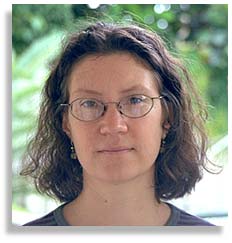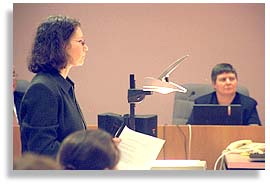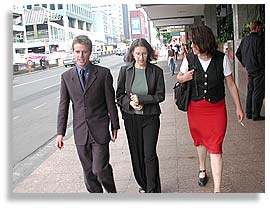|
Assessing the Risks of Genetic Engineering
Super weeds, non-target impacts, horizontal gene transfer Interview with Doreen Stabinsky Auckland, Aotearoa / New Zealand
Doreen Stabinsky is a science advisor for Greenpeace U.S. on the genetic engineering campaign. Her focus is the environmental effects of genetically engineered organisms in the environment. Her Ph.D is in genetics. She is trained as a plant geneticist. This interview is part of an extended series of articles and interviews gathered by In Motion Magazine in the context of the 2000-2001 hearings of New Zealand's Royal Commission on Genetic Modification. In Motion Magazine travelled around New Zealand with Missouri Rural Crisis Center and Natiional Family Farm Coalition president Bill Chrisitison visiting farmers and community leaders and listening to their views about genetically modified organisms. Currently there are no commercial GE crops in New Zealand. After hearing the recommendations of the commission the New Zealand government will make a decision on whether or not GE crops will be allowed in New Zealand. This interview was conducted February 17, 2001 by Nic Paget-Clarke. In Motion Magazine: When talking about genetic engineering, what does risk assessment mean? Doreen Stabinsky: Risk assessment means assessing the risks of the release of a genetically engineered organism. Risk is A composite analysis of the probability of an event occurring as well as the consequences of that event. With respect to genetic engineering, it's very difficult to do a risk assessment where you get real answers at the end. The probability of unpredictable events occurring is difficult to measure, and if you can't predict an event, you can't predict what is going to happen. It's difficult to understand what the consequences may be. In Motion Magazine: That's because it's a new science? Doreen Stabinsky: It's both because it's a new science and because the science is inherently unpredictable in terms of its impacts. What you are doing is you are moving genetic information from one organism to another and that's inherently unpredictable because you are creating a novel organism that's never before existed on the planet.You will never be able to predict what the impacts of putting new organisms in the environment can be. In Motion Magazine: So do the people who are working with these GE organisms say they can predict their impacts? Doreen Stabinsky: They do say they can. They think they can predict it to a certain degree. They compare genetically modified organisms to already existing organisms, using what they call the principle of familiarity. That is, if they know what the naturally occurring organism does, then they know what the genetically engineered organism will do. That's just a faulty assumption. In Motion Magazine: So when you say what you say, what do they say? They go back to their old argument? Doreen Stabinsky: They go back to their old argument. They can't picture the consequences that ecological scientists can picture in terms of the unpredictability of novel traits. I think they just haven't thought about it enough. So yes, they do go back to their old answer: 'We know what the organism is. We know what trait we are putting in the organism. Therefore we know what the novel organism will do in the environment.'
In Motion Magazine: From a scientific viewpoint, what are the main problems that have already come to light as far as genetically engineered crops and seeds. Doreen Stabinsky: There have been quite a few. In terms of laboratory experimentation, there has been a lot of documentation of unpredictable effects. You engineer an organism to do one thing, it does another. In terms of the crops that have been released, the effects that we have seen vary from soy beans whose stems crack in the heat because of the unpredictable increase in lignin content to cotton plants whose bolls drop off for no apparent reason. They still don't know why that happens. There's corn pollen that kills monarch butterfly larvae and probably other related larvae. And corn plants that exude pesticide into the soil. It's been shown that the pesticide then remains in the soil for over 200 days. That wasn't predicted and wasn't tested for." There's been a whole range of different effects that have been seen and we can expect that to continue. Super weeds, non-target impacts, horizontal gene transfer In Motion Magazine: Can they be categorized in concepts? For example, the idea of super weeds, or GE organisms drifting from one field to another? Doreen Stabinsky: Yes. There are super weeds that have been created through out-crossing, through cross-pollination. For example, in Canada, they planted three different herbicide resistant oil seed rape plants around the country, and, now they've found that out-crossing / cross-pollination has created weeds that are resistant to all three of those herbicides even though they were only singly-herbicide-resistant plants to begin with. There's wild relatives that live in the environment around the crop. The genetically engineered crop can become a crop weed itself or it can pass its GE traits on to other crops or wild relatives and those can become weeds. Another category is non-target impacts. The corn plant was engineered with a pesticide to kill a particular insect. The problem is that the corn plant can now also kill a lot of other insects when the pesticide it exudes into the soil remains in the soil. There are non-target impacts on a whole number of organisms that live in the soil. And then of course, there's the potential for horizontal gene transfer - the migration of the trait to another organism in the environment which then also has some ecological impact. In Motion Magazine: Are there dangers that you see that could be specific to New Zealand? Doreen Stabinsky: New Zealand has unique ecosystems. It has a wide range of threatened endangered species because of a long history of biological invasions. And New Zealand has special ecological situations so genetically engineered organisms as they manifest themselves will necessarily be different here than they would be in other parts of the world. But the same basic dangers are posed in environments all over the world. In Motion Magazine: Are these changes irreversible? Doreen Stabinsky: Genetically organized organisms are by the very nature of the fact that they are organisms, alive. They live. They reproduce. In that respect, yes, the changes are irreversible because you are talking about an organism that reproduces and distributes itself in the environment. Humans don't have a very good track record of once there's an organism that invades a particular environment of going out and being able to recall that organism. It just doesn't work that way. I don't know of any instance where eradication is one hundred percent complete. If you think of our attempts to eradicate pests, we are never successful at completely getting rid of them. In fact, more often than not when we try and get rid of a pest to crop plants, some insect pest, all we do is generate insecticide-resistant pests. The pest becomes that much harder to eradicate because it is resistant to our strategies to get rid of it. In Motion Magazine: What is the precautionary principle? Doreen Stabinsky: There are technologies such as genetic engineering which pose a potential for serious or irreversible harm. In the instances when you have a technology such as that, there is a moral imperative to take precautionary measures to make sure that that harm doesn't happen.
The precautionary principle has been instituted in international law and a number of international legal agreements. It's a principle of regulation in the European Union. In Motion Magazine: So, it is applicable in this case? Doreen Stabinsky: Yes. The triggering factor of the precautionary principle is 'a threat of serious or irreversible harm' and I think that that's clearly indicated with genetically engineered organisms. In Motion Magazine: How would you implement the principle? Doreen Stabinsky: Greenpeace's position is that to ensure implementation of the precautionary principle with respect to genetically engineered organisms, there should be a ban on releases into the environment. GMO's pose a long term threat of harm and the only way to make sure that you don't see that harm is to not release anything into the environment that could cause it. In Motion Magazine: What is the significance of the field trials? Doreen Stabinsky: Some people think that field trials can be more contained and hence less risky than commercial release. Obviously, with commercial release you are deliberately releasing genetically engineered organisms on a large scale, in the case of the U.S., tens of millions of acres. With field trials, you conduct them on a much smaller scale. But field trials are not contained. They are not contained, for example, becauses of at the end of the growing season the crop is generally plowed into the soil. It's not incinerated. There's no effort to get rid of every single trace of a genetically modified organism. Many field trials also allow flowering and setting of seed of the crops. If you allow flowering then there's the potential for pollen escape. For transgene escape. And, of course, setting of seed if you don't collect all the seeds. Greenpeace doesn't consider field trials at all contained. We should be talking about field trials as well when we talk about no introduction at all into the environment of genetically engineered organisms. In Motion Magazine: As a scientist, what do you think of the contention that with genetic engineering people are doing political action under the guise of science? Doreen Stabinsky: Some people think that science is completely objective and value free and that anytime values enter into science there's some ulterior motive, that it's not really science that is politically motivated. In fact, I don't think that any scientist enters the laboratory without their values. The assumption that science is completely objective and value free is a mistaken assumption. Genetic engineers, for example, have their own values that they bring into the laboratory. They also very often have significant financial interest in genetic engineering companies. That, I would say, is a very political element of the science that they do. In Motion Magazine: Do you think that corporations such as Monsanto and Novartis have a political motive? Doreen Stabinsky: I think they have a political economic motive. They are large corporations. The idea is to make money. Their appearance in a political forum is very much to try and maintain their economic position, their ability to come up with products, and to sell those products. Whether or not those products are inherently problematic for the environment, it is in their best economic interest to try and make sure that those products are regulated as little as possible. To continue to argue for little regulation, and to argue that products don't pose a risk to the environment. It is a fact that they wouldn't be in a very good financial position if people started believing that these corporate products are problematic for the environment. In Motion Magazine: What is your understanding of the long term strategy of biotech companies? Doreen Stabinsky: The long term strategy of the Life Science companies is to genetically engineer food products, food crops, because everybody has to eat. This is coupled with the patent system which gives them patents on those food crops. Without the patent system they wouldn't have the ability to control the food supply the way that they do. Patents mean that farmers can't save their seed and that farmers have to go back to the seed company year in and year out.
Originally, these companies were not in the seed business, they were in the agro-chemical biotechnology business. But, they started buying up seed companies and linking genetic engineering with the seed companies. They now have a degree of integration that allows them to come up with a new invention, patent that invention, and make sure that it is the only invention that the farmer has access to. We have a situation where there are very few seed companies that are distributing the majority of seed to farmers and those seed companies are the biotechnology companies. In Motion Magazine: What did you recommend to the commission? Doreen Stabinsky: Our recommendation to the commission was to stop the release into the environment of genetically engineered organisms. Our recommendation was for New Zealand to institute a ban on the release into the environment of GMO's, including field trials, including a ban on all field testing of engineered organisms. We also recommended to the commission that New Zealand should revoke patents on life forms. As I said, patents are a key aspect of the problem of genetic engineering. In Motion Magazine: From Greenpeace's global perspective, what do you think of the significance of these hearings? Doreen Stabinsky: I think they are highly significant. New Zealand is a very small country but individual countries taking a stand weakens the position of the genetic engineering industry. For instance, Italy has recently banned field trials and banned the importation of all genetically engineered corn into the country. That's caused some stirring in Europe and certainly it causes problems for the genetic engineering industry. In the United States, the line is that the genie is out of the bottle. It's impossible to segregate. This is the wave of the future and countries aren't going to be able to stop the importation of genetically engineered organisms whether it's in the food or whether it's for agriculture. But if countries like New Zealand take a strong stand, they send a message to the genetic engineering industry and to policy makers around the globe that you can say no. It's also an important message to send to consumers and environmentalists around the world that this is something that they can fight for in their own country. New Zealand can set a really important precedent. In Motion Magazine: What about the idea of a hearing, getting input from the people of New Zealand. Is that unique? Doreen Stabinsky: I think it's unique. We heard yesterday from Terje Traavik who said that in Norway they had a royal commission inquiry into genetically engineered organisms in food but, in fact, it was a commission of only scientists. Twelve scientists that met and went through the literature. There wasn't a system of public hearings. In that respect, the New Zealand commission hearings are quite good. I think that New Zealand could have expanded a little more on the public hearing, because in fact it's not everyone in the public who gets to present to the public hearing. People had to demonstrate interested-party status and all individuals that applied for interested-party status were denied. You only saw presentations on behalf of non-governmental organizations and the industry present in the country. Allowing more comprehensive input on the part of concerned citizens could have sent a stronger message from the New Zealand people to the Royal Commission about their concerns about GE. |
||||||||||||||||||||||||||||||||||||||||||||||||||||||||||||
|
Published in In Motion Magazine May 18, 2001. Also see:
|
||||||||||||||||||||||||||||||||||||||||||||||||||||||||||||
If you have any thoughts on this or would like to contribute to an ongoing discussion in the  What is New? || Affirmative Action || Art Changes || Autonomy: Chiapas - California || Community Images || Education Rights || E-mail, Opinions and Discussion || En español || Essays from Ireland || Global Eyes || Healthcare || Human Rights/Civil Rights || Piri Thomas || Photo of the Week || QA: Interviews || Region || Rural America || Search || Donate || To be notified of new articles || Survey || In Motion Magazine's Store || In Motion Magazine Staff || In Unity Book of Photos || Links Around The World || OneWorld / US || NPC Productions Copyright © 1995-2011 NPC Productions as a compilation. All Rights Reserved. |
||||||||||||||||||||||||||||||||||||||||||||||||||||||||||||





